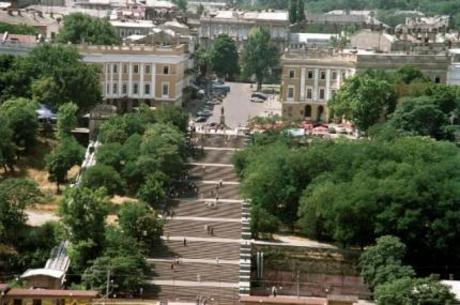Potemkin Stairs
Odessa is famous for Potemkin Stair which today consists of 192 steps. It connects the center of a city with a harbour and a marine station. Its length is 142 meters. It was projected in 1825 by an architect Franchesko Boffo. But it was built in 1838. Erosion gradually destroyed Stairs, and in 1933 sandstone was changed to pink and grey granite, and grounds were covered with asphalt. It was changing the names connected with a history of Odessa reason – Boulevard stair, before Seafront stair, Rishel’evskaya stair They were named in honor of the masterpiece of world cinema, the movie "Battleship Potemkin". In 2007 Potemkin Stairs were recognized as one of the most beautiful in Europe.
Currently the stairs consist of 192 steps (originally there were two hundred, but due to the expansion of the port some steps were filled). The length of the stairs is 142 meters, they are based perspective - their base is much wider than the top, so that when looking from Primorsky Boulevard, it seems the lack of view.
The Potemkin Stairs is a giant stairway in Odessa, Ukraine. The stairs are considered a formal entrance into the city from the direction of the sea and are the best known symbol of Odessa. Officially known today as the Primorsky Stairs, they were originally known as the Boulevard steps, the Giant Staircase, or the Richelieu steps.
The top step is 12.5 metres (41 ft) wide, and the lowest step is 21.7 metres (70.8 ft) wide. The staircase is 27 metres high, and extends for 142 metres, but it gives the illusion of greater length. The stairs were designed to create an optical illusion. A person looking down the stairs sees only the landings, and the steps are invisible, but a person looking up sees only steps, and the landings are invisible. A secondary illusion creates false perspective since the stairs are wider at the bottom than at the top. Looking up the stairs makes them seem longer than they are and looking down the stairs makes them seem not so long.
The stairs were designed by architect Francis Boffo in 1825. The construction of the stairs was completed in 1841. They were built as a gift to wife of Prince Vorontsov. Originally Potemkin Stairs had more aesthetic features than practical ones. In front of the stairs there is a monument to Duke de Richelieu, which is a visiting card of Odessa. In 1837, the decision was made to build a "monstrous staircase", which was constructed between 1837 and 1841. An English engineer named John Upton constructed the stairs. Upton had fled Britain while on bail for forgery. Greenish-grey sandstone from the extreme northeastern Italian town of Trieste (at the time it was an Austrian town) was shipped in.
The steps were made famous in Sergei Eisenstein's 1925 silent film The Battleship Potemkin; according to the fictionalized account in that film, soldiers opened fire on the people on the stairs on June 14, 1905. According to journalist Chukovsky, who was in the city during the events, it is unknown whether the Cossacks at the top of the stairs, that were filled with people, actually opened fire on the stairs. In Eisenstein's movie the horrific events that actually took place in various parts of the city were concentrated at the stairs. Noted film critic Roger Ebert writes, "That there was, in fact, no Czarist massacre on the Odessa Steps scarcely diminishes the power of the scene ... It is ironic that [Eisenstein] did it so well that today the bloodshed on the Odessa steps is often referred to as if it really happened."
As erosion destroyed the stairs, in 1933 the sandstone was replaced by rose-grey granite from the Southern Bug area, and the landings were covered with asphalt. Eight steps were lost under the sand when the port was being extended, reducing the number of stairs to 192, with ten landings.
After the Soviet revolution, in 1955 the Primorsky Stairs were renamed Potemkin Stairs to honor the 50th anniversary of the Battleship Potemkin uprising.
In different sources the stairs wer called differently: "Giant", "Boulevard" and "Vorontsov". The official name of Potemkin appeared only in 1951, although almost immediately after the release of the film "Battleship Potemkin" the stairs began to be called Potemkin.
Near the stairs there is the funicular. It was built in 1902, and in 1970 replaced with the escalator. At the beginning of 90th years the escalator broke down. And ten years ago, in 2005, the funicular was restored.




